Vintage Audio & Hi-Fi Equipment
1992 Sony Discman Model D-11 CD Player
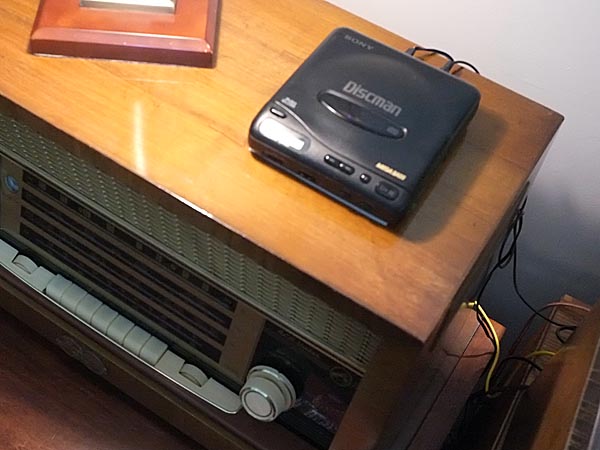 Why is there a Sony Discman on a vintage audio and hi-fi page, you ask? Well, some consider the Sony Discman CD players of the 1980's and early 1990's as "classics" if not vintage. They are about thirty years old, give or take a couple years either way. While they are supposedly portable CD players, in reality, not so much. Mostly of metal construction, with a few plastic parts, such as the CD cover lid, they are not light compared to todays models. They have no buffers, so they don't take kindly to bumps and shakes, resulting in skips in the audio.
Why is there a Sony Discman on a vintage audio and hi-fi page, you ask? Well, some consider the Sony Discman CD players of the 1980's and early 1990's as "classics" if not vintage. They are about thirty years old, give or take a couple years either way. While they are supposedly portable CD players, in reality, not so much. Mostly of metal construction, with a few plastic parts, such as the CD cover lid, they are not light compared to todays models. They have no buffers, so they don't take kindly to bumps and shakes, resulting in skips in the audio.
On the other hand, the audio quality is considered to be superior to most CD players made today by Discman enthusiasts. As such, certian models are highly sought after, and prices on some models are quite high. Keep in mind that these CD players cost around $300 or more when introduced thirty years ago.
I bought this Model D-11 on Ebay for about $30. It came with no accessories. I have a box of AC adapters, and rummaging through it, I actually found the exact Sony AC adapter that shipped with the unit when new. A good thing, too, as it will eat through a set of AA's in about eight hours, or less. I bought this player to connect to my RCA International Model 9-INT-1 so I could play CD's through the tape input. It works perfectly for that application, and it doesn't get jostled around, and I can run it off the AC adapter.
1955 Voice of Music Model 700 Tape Recorder
 The Model 700 is Voice of Music's first tape recorder. This is a two-track, monaural model, with high fidelity sound reproduction. It can handle 7" tape reels. The build date on this example, which I found on Ebay, is April, 1955. Production of the Model 700 began in 1954.
The Model 700 is Voice of Music's first tape recorder. This is a two-track, monaural model, with high fidelity sound reproduction. It can handle 7" tape reels. The build date on this example, which I found on Ebay, is April, 1955. Production of the Model 700 began in 1954.
I actually purchased the recorder in late 2015, and did a complete tear-down to clean and restore it in December, 2015. One nice thing about Voice of Music products is that Gary Stork, at The Voice of Music has all the parts, including new belts and wheels, needed to fully restore one of these beautiful machines.
I ordered a full kit of belts and wheels. While waiting for those parts to come in the mail, I recapped the amplifier and replaced a number of resistors that were in bad shape. But as the Christmas holidays were near, I put the project aside. Somehow, I just never got back to it, and as the years went by, it began to nag at me, until the Coronavirus hit the U.S., and our governor issued stay at home orders. This seemed like a good time to get back on the project, so I pulled all the pieces out of storage, and studied the manuals and my tear-down photos to refresh my memory.
I installed the new belts, idler wheel, and capstan drive wheel. I then began working through the lubrication chart, and discovered a missing part, which I could not find anywhere. Looking at my tear-down photos (this is why I always take many photos as I disassemble vintage electronics), I found it was missing when I got the machine. No problem, I ordered the part from Gary at Voice of Music, and when it arrived a few days later, I finished re-assembling the recorder.
Before putting the completed chassis back in the case, I decided to test the functions, and found that as soon as the power was turned on, the recorder immediately started spinning the take up reel at fast-forward speed. So I had to take off the top of the unit containing all the mechanisms, and I immediately saw that I had installed a belt wrong. I rerouted the belt correctly, and tested again, and it worked as it should.
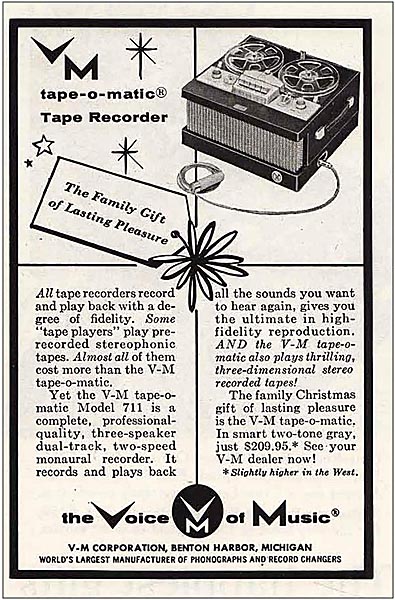 Next, I tested the amplifier with an old tape I had on hand, but as it was a four-track stereo tape, the audio was garbled due to cross-talk from the stereo channels, but I could tell the amplifier was working fine. I then plugged in a microphone and did a test, which also turned out well. Finally, I fed a signal from a turntable into the phono input and recorded a track of music, and that worked fine too. In fact, the audio quality of the amplifier, which uses a 12AX7 pre-amp tube, and two 6V6 output tubes, is quite good.
Next, I tested the amplifier with an old tape I had on hand, but as it was a four-track stereo tape, the audio was garbled due to cross-talk from the stereo channels, but I could tell the amplifier was working fine. I then plugged in a microphone and did a test, which also turned out well. Finally, I fed a signal from a turntable into the phono input and recorded a track of music, and that worked fine too. In fact, the audio quality of the amplifier, which uses a 12AX7 pre-amp tube, and two 6V6 output tubes, is quite good.
I will probably record some of my old 78 albums on tape, and play the tape now and then to keep the recorder exercised, but tape is sadly not archival. Old tape gets brittle and snaps, and sheds ferric oxide like crazy on the tape heads and rollers. Although 78 records are easily scratched and broken, if cared for, they are actually as archival as you can get if not played too often. Each play, though, removes a little surface from the disc. Copying to tape eliminates the need to play individual records, at least until the tape wears out, and as an analog to analog technology, it is much easier than transfering vinyl to a hard drive or CD.
Reel to reel tape recorders using magnetic tape have an interesting history. Originally developed in Germany in the late 1920's and 1930's, the technology was perfected by Nazi Germany during WWII and used by Hitler for his prograganda broadcasts.
Jack Mullen, a US Army Signal Corps audio engineer, brough back several German tape recorders from Germany after the war. His goal was to interest Hollywood movie studios in the technology and also to develop its commercial potential for hi-fi enthusiasts, as the high fidelity properties of the machines and recordings were state-of-the-art, and still are, as far as analogy recordings are concerned.
Mullins was able to introduce Bing Crosby to the technology, and Crosby immediately saw the potential. He invested in the project, and Ampex and Mullins devloped many tape recorders, including stereo models, over the years. Bing Crosby was one the of first performers to use tape to pre-record his radio shows.
1952 Browning RV31 FM Tuner
 Browning made a series of FM tuners in the early to mid-fifties that are very good. Browning is probably better known, however, for their line of highly regarded CB radios from the 1970's. I found this FM tuner on eBay for just a few dollars. The Browning RV31 is a ten tube FM tuner with excellent stability and audio output. It can hold its own with most modern day tuners.
Browning made a series of FM tuners in the early to mid-fifties that are very good. Browning is probably better known, however, for their line of highly regarded CB radios from the 1970's. I found this FM tuner on eBay for just a few dollars. The Browning RV31 is a ten tube FM tuner with excellent stability and audio output. It can hold its own with most modern day tuners.
 Browning generally sold its tuners as a chassis only as they were intended to be mounted in the customers console or rack. The example I purchased has been installed in a homebrew cabinet.
Browning generally sold its tuners as a chassis only as they were intended to be mounted in the customers console or rack. The example I purchased has been installed in a homebrew cabinet.
I replaced the electrolytic filter caps and all the wax/paper caps under the chassis. I also replaced one dead tube. The 6AL7 eye tube was extremely weak, so I replaced it with a NOS 6AL7.
I use it with an RCA 9-INT-1 or a Bell 2256 amplifier, and it performs very well with either.
1954 Magnavox 252MX Console
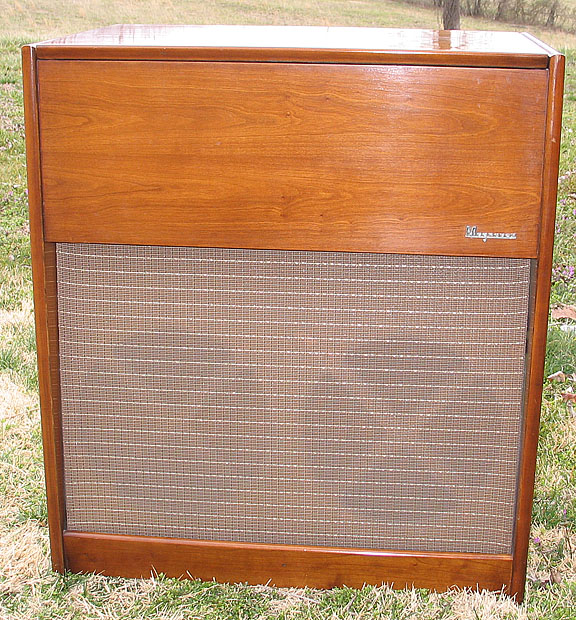 I found this very nice Magnavox console in a thrift shop for $20.00. It was complete except for the record changer. This unit has the CR700AA am/fm tuner and pre-amp, and the 132AA amplifier, a parallel push-pull amplifier using four 6V6GT tubes for output through two 12-inch speakers with embedded tweeters connected through a crossover network. It is a monoaural amplifier, pre-dating the commercial debut of stereo by five years. Cosmetically, the unit was in excellent condition with just some slight crazing of the lacquer on the lid.
I found this very nice Magnavox console in a thrift shop for $20.00. It was complete except for the record changer. This unit has the CR700AA am/fm tuner and pre-amp, and the 132AA amplifier, a parallel push-pull amplifier using four 6V6GT tubes for output through two 12-inch speakers with embedded tweeters connected through a crossover network. It is a monoaural amplifier, pre-dating the commercial debut of stereo by five years. Cosmetically, the unit was in excellent condition with just some slight crazing of the lacquer on the lid.
At some point in the console's previous life, someone had disconnected the tuner and amp from the speaker network. The speakers were connected to an ugly fader switch mounted adjacent to the tuner dial and contols, and the console was apparently used as an extension speaker, perhaps for a guitar amp.

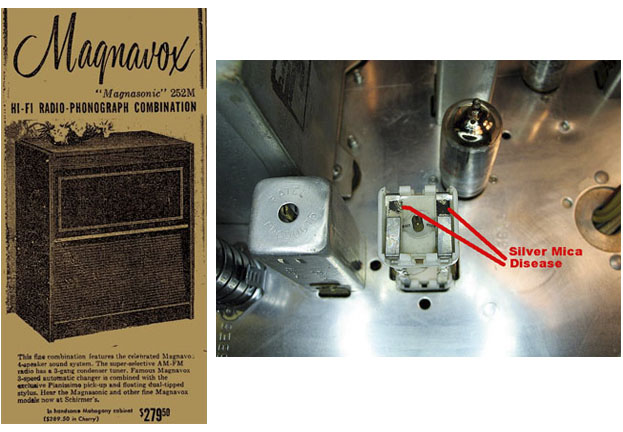 In addition to the usual cleaning, lubrication, adjustments, restoration consisted of recapping the tuner and amplifier and replacing bad resistors. Despite days of troubleshooting, I was unable to get decent FM. Volume was low and reception would fade away. I finally determined that the intermediate frequency transformers had silver mica disease, a common problem in some post-war IF transformers. Curing SMD requires determining the value of the mica caps in the IF transformers. If the value is not published in the schematic, a capacitance meter can be used to measure the value. Then the bad capacitors are removed and new ones soldered in.
In addition to the usual cleaning, lubrication, adjustments, restoration consisted of recapping the tuner and amplifier and replacing bad resistors. Despite days of troubleshooting, I was unable to get decent FM. Volume was low and reception would fade away. I finally determined that the intermediate frequency transformers had silver mica disease, a common problem in some post-war IF transformers. Curing SMD requires determining the value of the mica caps in the IF transformers. If the value is not published in the schematic, a capacitance meter can be used to measure the value. Then the bad capacitors are removed and new ones soldered in.
The missing OEM record changer was a Chicago-Webster 3-speed unit. While it is possible to find these old Webster units, I decided to update the record changer. I found a nice 1960's era Magnavox Micromatic S600 record changer on eBay. The Magnavox Micromatic changers were built in England by Collaro, and are very well built changers. The Micromatic can be equipped with a ceramic cartridge to play sterophonic records, although the stereo is converted back to monaural. I had to build a new platform with the correct cut-out to fit in the record changer well. Also it turned out the Micromatic was a little too large for the well, and the original lid support bracket mounted on the left side of the cabinet prevented the records from dropping on to the turntable. I had to remove that and fabricate a special lid support from a bracket I found at Home Depot.
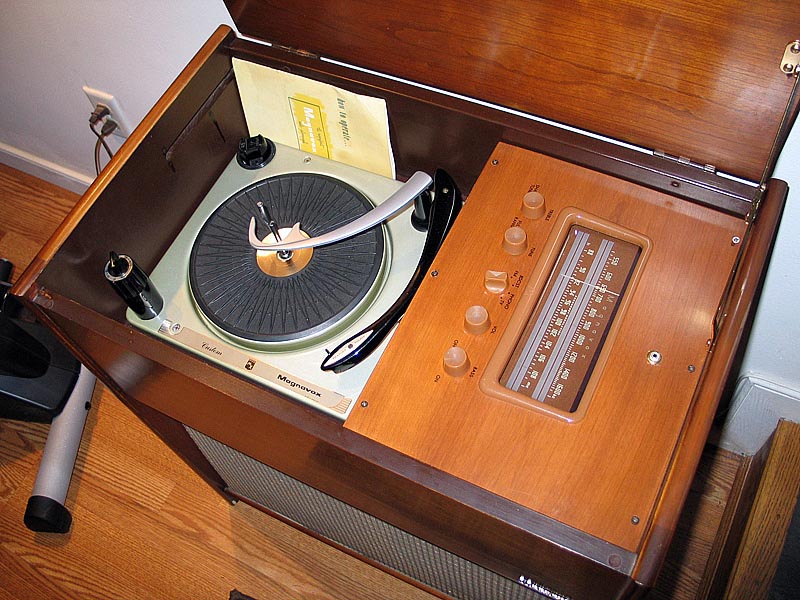
I installed a 3.5mm audio-in jack where the fader switch was removed as that left a hole that couldn't be easily repaired. An iPod or CD player can be plugged into the jack and played through the amplifier, with excellent sound. In fact, LP's sound awesome played through this unit, with clear vibrant highs and very pleasing mid-tones. Bass reproduction is appropriate for the era, but youngsters raised on sub-woofers and thumping bass might be disappointed. Magnavox was a high-end manufacturer of hi-fidelity and stereophonic audio equipment and televisions from the 1920's through the 1970's. Although still a well-known brand, current products, like most electronics today, are made in Asia and are no longer targeted to the upscale consumer.
Click here to see and hear it play
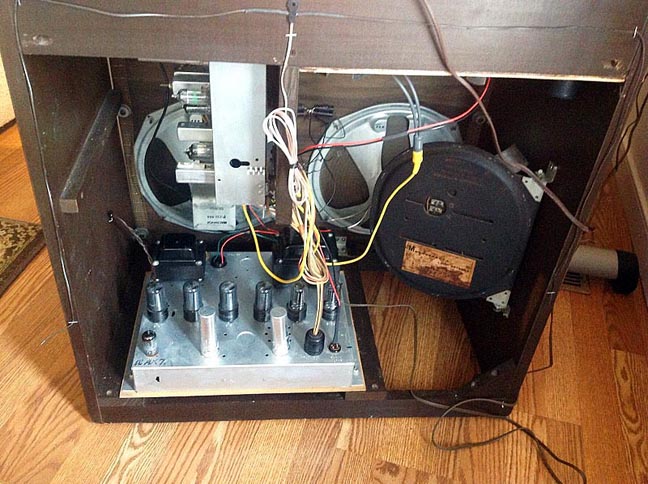
Bell Golden Twins

1955 Bell Model 2256 High Fidelity Amplifier
Another change of pace project. I purchased this amplifier for a couple dollars at an auction. It was dirty and missing the knobs, but otherwise looked to be complete, and no tubes were missing. Before beginning restoration, I wanted to see what issues it might have, so I hooked it up to a test speaker, and brought the amplifier up slowly over the course of an hour on a variac. At about 80 volts, I could hear buzzing in the speaker, which told me it worked. I connected an iPod to the tape input and music came out of the speaker.
Restoration consisted of replacing the rotten power cord, the electrolytic capacitors, and all the paper caps. I replaced one power resistor that had drifted high, but all the others were within tolerance.
I also cleaned up the cabinet and repainted it, except for the front panel, which I cleaned with dishwashing soap and water to avoid damage to the lettering on the front. I polished screw heads and the pilot lamp bezel, and installed a new set of knobs from Radio Shack. Finally, I installed new felt pads on the bottom of the case.

This is a six tube high fidelity amplifier. It has a 5Y3 rectifier, three 12AX7's, and two 6V6GT's for push-pull output. It is a monaural amplifier as it pre-dates stereophonic sound. It is rated at 12 watts with less than 1% distortion. It has inputs for magnetic, ceramic, and crystal phono cartridges, tape or TV, and radio. I have it connected to a vintage Realistic MC-1000 speaker I found at a thrift store. Sound reproduction is very good. CD's sound great and I have my turntable connected to it for playing LP's. And it is an awesome iPod player.
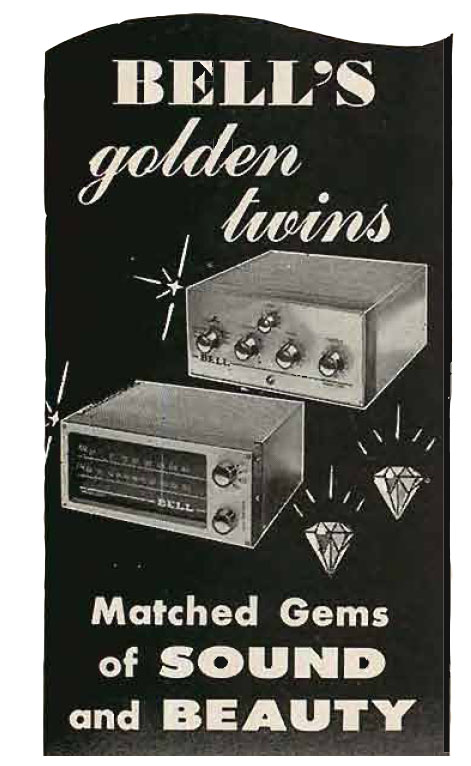

1955 Bell Model 2255 AM/FM Tuner
After restoring the 1955 Bell 2256 amplifier, I begain searching for an AM/FM tuner to go with it. I picked up a Bell 2520 (see below) first, restored it, and used it until I found a Bell 2255 AM/FM tuner. The Bell 2255 was made as a companion to the 2256 amplifer, so it is the correct one to use.
 The tuner played very well as found, and when I opened it up, I could see that some work had been done on it. The work appears to have been done by a radio shop, but I'm not too crazy about how it was done--a couple of electroytic caps jumpered from the can terminals to B- (the two large red caps in the photo below). I've since replaced the electrolytic caps along with all the paper caps and out-of-tolerance resistors.
The tuner played very well as found, and when I opened it up, I could see that some work had been done on it. The work appears to have been done by a radio shop, but I'm not too crazy about how it was done--a couple of electroytic caps jumpered from the can terminals to B- (the two large red caps in the photo below). I've since replaced the electrolytic caps along with all the paper caps and out-of-tolerance resistors.
The built-in ferrite am antenna does not work well. Although the ferrite loop tests ok, the signal is weak, and I haven't been able to figure out why. However, simply connecting an external AM antenna solves the problem of AM reception. FM reception with a diplole FM antenna from Radio Shack is excellent.
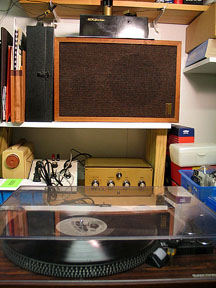 I also repainted the unit, except for the front. Although the tuner came with the original knobs, I added new knobs from Radio Shack to match the knobs I put on the Bell 2256 amplifier, as it had none when I acquired it.
I also repainted the unit, except for the front. Although the tuner came with the original knobs, I added new knobs from Radio Shack to match the knobs I put on the Bell 2256 amplifier, as it had none when I acquired it.
The Bell amplifier owner's manual said to leave 3/4" space between components when stacking, so I made new feet for the tuner from wood dowel and installed them on the bottom of the tuner.
I use my "Golden Twins" nearly every day. I use a Talking House AM transmitter to rebroadcast XM satellite stations to the AM broadcast band so I can tune XM on any of my AM only vintage radios. So I can listen to my favorite XM channels on my "Golden Twins" on am. Or I can tune in my favorite FM stations. I also have a turntable and CD player connected to the Bell 2256 amplifier, so I can play LPs or CDs. I can also feed audio from my iPod via the tape input on the Bell 2256. Output from the Bell 2256 is to a vintage Radio Shack M1000 speaker, shown in the photo at left, before I acquired the Bell 2255 tuner.

1957 Bell Model 2520 High Fidelity AM/FM Tuner
After restoring the Bell 2256 amplifier above, I thought I would see if I could find an AM/FM tuner to use with it. As luck would have it, I found a Bell 2520 tuner on eBay.
This tuner is a little newer than the 2256 amplifier, and was actually intended to be paired with one of the Bell 23xx series amplifiers.
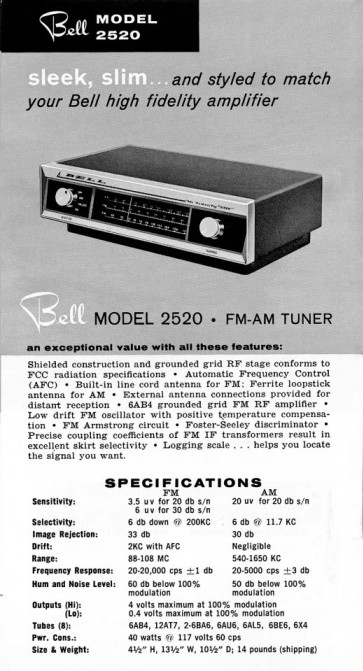 I found one bad tube, the 6AB4 FM RF amplifer, and a burned out dial lamp. While I waited for a new 6AB4 to arrive, along with some #44 dial lamps and some caps, I did a thorough cleaning, replaced two .05 uF paper caps (all the rest are disc caps), and checked tolerances on resistors. I installed a new power cord.
I found one bad tube, the 6AB4 FM RF amplifer, and a burned out dial lamp. While I waited for a new 6AB4 to arrive, along with some #44 dial lamps and some caps, I did a thorough cleaning, replaced two .05 uF paper caps (all the rest are disc caps), and checked tolerances on resistors. I installed a new power cord.
The electrolytic capacitors in the tuner are a trio of 20 uF/450 volt caps in a can. I replaced them with three 22 uF caps. I encountered the same problem I did with the Bell amplifier earlier, i.e.,the old can top wouldn't fit over the new caps, so I just left the can off.
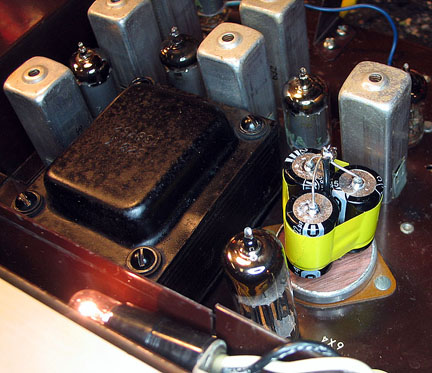
With the new caps, dial lamps and a new 6AB4 installed, I connected the tuner to the Bell 2256 amplifier, then brought the tuner up slowly on the Variac. Current draw looked OK, and at about 100 volts, I got nice AM reception through the amplifier and speaker. On AM, it picked up all the local stations, and then I switched to FM and FM-AFC and again it picked up all the local stations nicely. This was one of the easiest restorations I've done. It took longer to clean it and reassemble it than it did to do the electronics
Back to Record Player & Audio Menu



 Why is there a Sony Discman on a vintage audio and hi-fi page, you ask? Well, some consider the Sony Discman CD players of the 1980's and early 1990's as "classics" if not vintage. They are about thirty years old, give or take a couple years either way. While they are supposedly portable CD players, in reality, not so much. Mostly of metal construction, with a few plastic parts, such as the CD cover lid, they are not light compared to todays models. They have no buffers, so they don't take kindly to bumps and shakes, resulting in skips in the audio.
Why is there a Sony Discman on a vintage audio and hi-fi page, you ask? Well, some consider the Sony Discman CD players of the 1980's and early 1990's as "classics" if not vintage. They are about thirty years old, give or take a couple years either way. While they are supposedly portable CD players, in reality, not so much. Mostly of metal construction, with a few plastic parts, such as the CD cover lid, they are not light compared to todays models. They have no buffers, so they don't take kindly to bumps and shakes, resulting in skips in the audio. The Model 700 is Voice of Music's first tape recorder. This is a two-track, monaural model, with high fidelity sound reproduction. It can handle 7" tape reels. The build date on this example, which I found on Ebay, is April, 1955. Production of the Model 700 began in 1954.
The Model 700 is Voice of Music's first tape recorder. This is a two-track, monaural model, with high fidelity sound reproduction. It can handle 7" tape reels. The build date on this example, which I found on Ebay, is April, 1955. Production of the Model 700 began in 1954. Next, I tested the amplifier with an old tape I had on hand, but as it was a four-track stereo tape, the audio was garbled due to cross-talk from the stereo channels, but I could tell the amplifier was working fine. I then plugged in a microphone and did a test, which also turned out well. Finally, I fed a signal from a turntable into the phono input and recorded a track of music, and that worked fine too. In fact, the audio quality of the amplifier, which uses a 12AX7 pre-amp tube, and two 6V6 output tubes, is quite good.
Next, I tested the amplifier with an old tape I had on hand, but as it was a four-track stereo tape, the audio was garbled due to cross-talk from the stereo channels, but I could tell the amplifier was working fine. I then plugged in a microphone and did a test, which also turned out well. Finally, I fed a signal from a turntable into the phono input and recorded a track of music, and that worked fine too. In fact, the audio quality of the amplifier, which uses a 12AX7 pre-amp tube, and two 6V6 output tubes, is quite good. Browning made a series of FM tuners in the early to mid-fifties that are very good. Browning is probably better known, however, for their line of highly regarded CB radios from the 1970's. I found this FM tuner on eBay for just a few dollars. The Browning RV31 is a ten tube FM tuner with excellent stability and audio output. It can hold its own with most modern day tuners.
Browning made a series of FM tuners in the early to mid-fifties that are very good. Browning is probably better known, however, for their line of highly regarded CB radios from the 1970's. I found this FM tuner on eBay for just a few dollars. The Browning RV31 is a ten tube FM tuner with excellent stability and audio output. It can hold its own with most modern day tuners. Browning generally sold its tuners as a chassis only as they were intended to be mounted in the customers console or rack. The example I purchased has been installed in a homebrew cabinet.
Browning generally sold its tuners as a chassis only as they were intended to be mounted in the customers console or rack. The example I purchased has been installed in a homebrew cabinet. I found this very nice Magnavox console in a thrift shop for $20.00. It was complete except for the record changer. This unit has the CR700AA am/fm tuner and pre-amp, and the 132AA amplifier, a parallel push-pull amplifier using four 6V6GT tubes for output through two 12-inch speakers with embedded tweeters connected through a crossover network. It is a monoaural amplifier, pre-dating the commercial debut of stereo by five years. Cosmetically, the unit was in excellent condition with just some slight crazing of the lacquer on the lid.
I found this very nice Magnavox console in a thrift shop for $20.00. It was complete except for the record changer. This unit has the CR700AA am/fm tuner and pre-amp, and the 132AA amplifier, a parallel push-pull amplifier using four 6V6GT tubes for output through two 12-inch speakers with embedded tweeters connected through a crossover network. It is a monoaural amplifier, pre-dating the commercial debut of stereo by five years. Cosmetically, the unit was in excellent condition with just some slight crazing of the lacquer on the lid.
 In addition to the usual cleaning, lubrication, adjustments, restoration consisted of recapping the tuner and amplifier and replacing bad resistors. Despite days of troubleshooting, I was unable to get decent FM. Volume was low and reception would fade away. I finally determined that the intermediate frequency transformers had silver mica disease, a common problem in some post-war IF transformers. Curing SMD requires determining the value of the mica caps in the IF transformers. If the value is not published in the schematic, a capacitance meter can be used to measure the value. Then the bad capacitors are removed and new ones soldered in.
In addition to the usual cleaning, lubrication, adjustments, restoration consisted of recapping the tuner and amplifier and replacing bad resistors. Despite days of troubleshooting, I was unable to get decent FM. Volume was low and reception would fade away. I finally determined that the intermediate frequency transformers had silver mica disease, a common problem in some post-war IF transformers. Curing SMD requires determining the value of the mica caps in the IF transformers. If the value is not published in the schematic, a capacitance meter can be used to measure the value. Then the bad capacitors are removed and new ones soldered in.





 The tuner played very well as found, and when I opened it up, I could see that some work had been done on it. The work appears to have been done by a radio shop, but I'm not too crazy about how it was done--a couple of electroytic caps jumpered from the can terminals to B- (the two large red caps in the photo below). I've since replaced the electrolytic caps along with all the paper caps and out-of-tolerance resistors.
The tuner played very well as found, and when I opened it up, I could see that some work had been done on it. The work appears to have been done by a radio shop, but I'm not too crazy about how it was done--a couple of electroytic caps jumpered from the can terminals to B- (the two large red caps in the photo below). I've since replaced the electrolytic caps along with all the paper caps and out-of-tolerance resistors. I also repainted the unit, except for the front. Although the tuner came with the original knobs, I added new knobs from Radio Shack to match the knobs I put on the Bell 2256 amplifier, as it had none when I acquired it.
I also repainted the unit, except for the front. Although the tuner came with the original knobs, I added new knobs from Radio Shack to match the knobs I put on the Bell 2256 amplifier, as it had none when I acquired it.
 I found one bad tube, the 6AB4 FM RF amplifer, and a burned out dial lamp. While I waited for a new 6AB4 to arrive, along with some #44 dial lamps and some caps, I did a thorough cleaning, replaced two .05 uF paper caps (all the rest are disc caps), and checked tolerances on resistors. I installed a new power cord.
I found one bad tube, the 6AB4 FM RF amplifer, and a burned out dial lamp. While I waited for a new 6AB4 to arrive, along with some #44 dial lamps and some caps, I did a thorough cleaning, replaced two .05 uF paper caps (all the rest are disc caps), and checked tolerances on resistors. I installed a new power cord.